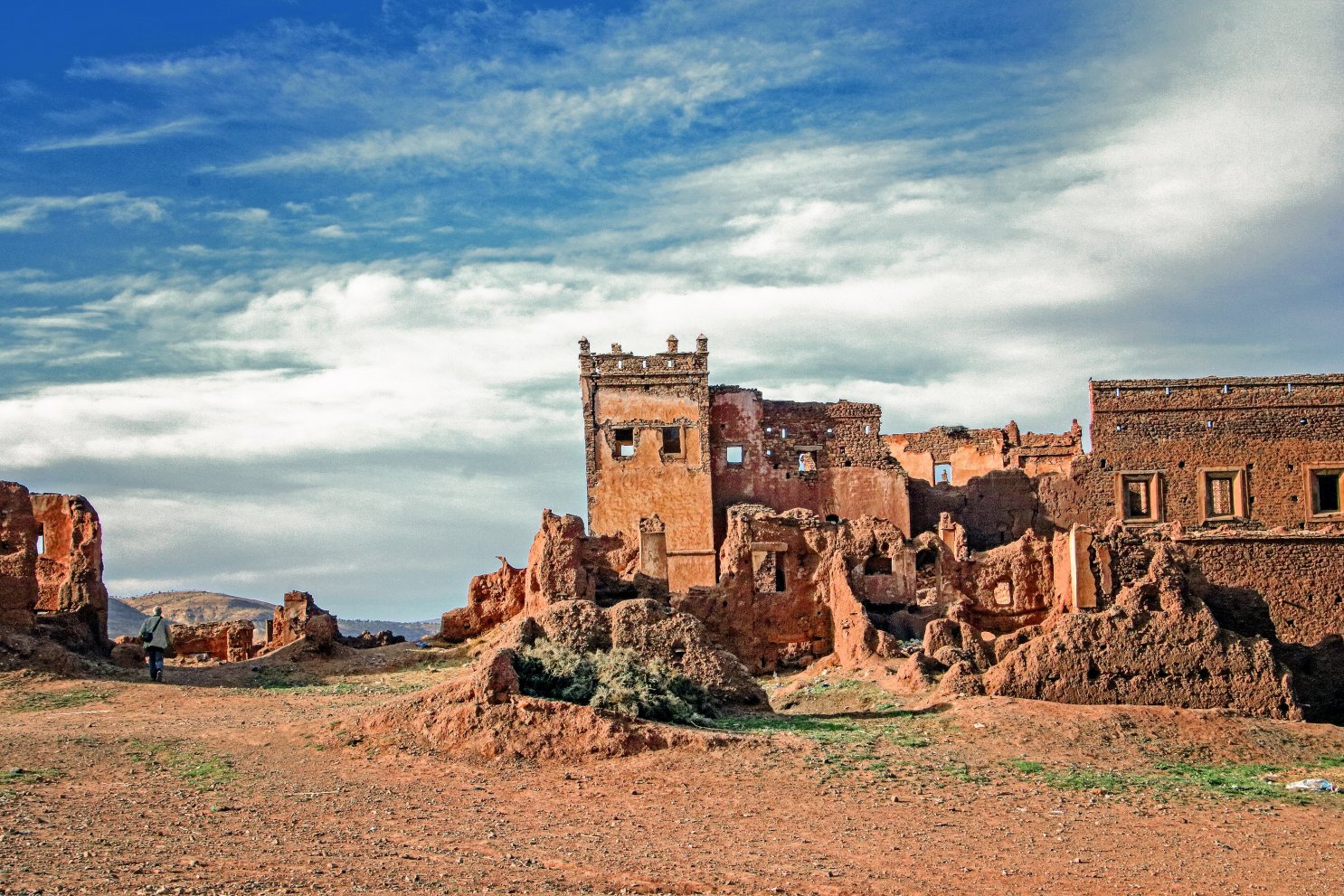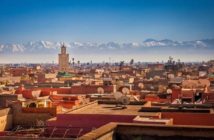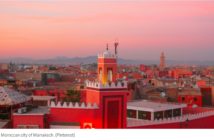The San Diego Union-Tribune (TNS)
By Norma Meyer
AP
In dizzyingly exotic Morocco, I’ll scurry past snake charmers and lurching cobras, hang onto a bouncy camel for dear life and haggle for bargains in mysterious carpet-swathed ancient medinas.
And now, in the serene far-flung mountains, I’m stooped inside a cubbyhole limestone cave watching a crouching 75-year-old Berber nomad named Ahmed hospitably brew mint tea for me while his baa-ing sheep graze nearby. A father of five with a weather-beaten, lined face, he’s cloaked in a traditional beige djellaba robe and tagelmust turban wrapped on his head and under his chin’s graying beard. Although he speaks no English, he welcomes a dozen of us who are on a rugged half-day hike in the spectacular sheer-sided Todra Gorge when we stumble into his rocky makeshift camp.
“American. Barack Obama,” my Berber translator-guide soon tells him, pointing to me, the lone Yankee, as we sip hot tea inside a fraying goat-hair tent.
“Ahh,” the septuagenarian’s crinkly eyes light up. He nods at his 3-year-old son — yes, his son — who it turns out is also named Barack. (Ahmed’s wife is much younger, plus “nomads are very strong,” my grinning guide later explains.)
This memorable encounter — and many more — occurs on my captivating 15-day, 1,200-mile road trip crisscrossing the North African country in a tour van with small-group adventure company Exodus Travels. We journey past crumbling fairy-tale fortresses on the palm-tree-garnished “Route of a Thousand Kasbahs,” explore UNESCO World Heritage sites that look straight out of a Hollywood movie (in fact, “Gladiator” was filmed at one medieval mud-brick enclave), and with our Exodus guide Mohamed are immersed in the colorful indigenous Berber culture at every stop. (So far, I’ve swallowed an ocean full of “Berber Whiskey,” the always-offered sweet mint tea that is ceremoniously poured into little clear glasses from a height — as nomad Ahmed did — to show respect to guests. Most Berbers are Muslims and abstain from alcohol.) For added atmosphere, we sleep in centuries-old mosaic-festooned homes (riads), a quirky casbah-motif hotel and a Berber desert tent camp set deep in titanic sand drifts near Algeria.
“Balak! Balak!” shout donkey cart drivers, meaning “Move aside!” which I do, although I’m distracted by two furry severed camel heads dangling from the camel meat shop in Fez’s narrow, hustle-bustle UNESCO-lauded medina. The ninth century-founded old town is a mesmerizing twisty maze of 9,400 skinny lanes, alleys and dead ends jammed with merchandise-packed souks (spices, olives, rugs, brocade sequined gowns for Moroccan brides who may have up to seven changes of clothes during their wedding), and intricate zellij-tiled mosques, cedar-carved Islamic academies and iron-doored residences. Our local guide, Aziz, sternly warns us to follow him; he says — jokingly, I think — that female tourists who get lost end up in harems. It’s living history on sensory steroids — caftan-wearing craftsmen loudly pound copper and brass into teapots, pans and lanterns; weavers spin silk from agave cactus into rainbow-bright bedspreads and scarves, and gag-smelly tanneries produce leather goods from animal hides dipped into vats of dye.
Forty-eight hours after frenetic Fez, we’re in the expansive peaceful desert on a crisp February day. I’ve ridden a camel before, but the one I teeter upon this time is surely the world’s tallest dromedary, his every step sinking into bottomless sand on the rolling Erg Chebbi dunes while I tilt, flounce and death-grip small handlebars. The landscape is storybook beautiful — just turquoise skies and infinite honey-hued sand that can reach 500 feet high, the same fabled desert that ancient camel caravans traversed carrying salts, gold and spices to Timbuktu.
A bumpy 90 minutes later, at our simple tent camp, I dismount (pitching forward over my camel with a scream). Mohamed, in Berber-style indigo-blue cloak and flowing turban, soon leads us up a gigantic dune, our shoes punching craters in flawlessly smooth sand. From atop the powdery peak, we’re transfixed as the setting sun radiates fiery orange and pink glows over wavy wind-sculpted dunes that go on forever. The next predawn morning, I’m awakened by bellowing camels outside my tent (think of T-Rex roars). On the ride back, my one-hump ungulate feels steadier, but then I’m entranced by the dazzling egg yolk-yellow sunrise.
What I like about Exodus — besides alluring itineraries and prices — is the company’s charitable involvement with visited communities (this is my third international trip with Exodus; 10 of my British travel mates are multi-repeat customers). One afternoon, miles after our excellent driver, Youssef, deftly handles clifftop hairpin turns, we arrive at a dirt path for a 90-minute walk — mules take our luggage — to the remote rural village of Tighza 6,200 feet up in the snowcapped High Atlas Mountains. Here, some older Berber women have tribal chin tattoos of dark, straight lines and gather hefty bushels of alfalfa and barley from fields. Also, this is where Exodus in 2012 funded and built a customary hammam, which is a public bath that is an important place for local women to socialize. Tighza’s hammam also generates income for villagers since Exodus pays for its own clients, who each add in another 40 dirham (about $4).
The following day, I’m basically in the buff lying face-up on a heated tile floor of an empty room alongside three similar prone female Exodus cohorts. Each of us has an assigned woman villager — all modestly dressed and wearing traditional headscarves — who briskly scrubs our body with an exfoliating mitt and black-olive-oil soap. I’m almost slap-happy as wood-heated warm water is ladled from large plastic buckets and repeatedly doused over me. This hammam is a wonderful authentic experience, and an hour later when it’s over, I’m rubber-kneed relaxed.
Earlier, another Berber named Ahmed — this one is 32 years old — strolls with me through Tighza before graciously inviting me for mint tea in his kitchen with his mother and 15-month-old daughter. “Exodus has been very very good to us,” he says. The hammam and other Exodus donations have provided money “for schools, for people to get operations at the hospital … to fix water pipes, to rebuild houses destroyed by the flood” in 2014. Our group soon delivers packages we’ve brought from home — classroom supplies, gardening gloves and toothbrushes — to a grateful teacher at the village school.
Throughout our adventure, hours on the road are never dull. We stop to amble through the dramatic Roman ruins of onetime capital Volubilis; peer at bizarre climbing goats who perch on high branches of argan trees to eat fruit, and wander through a Berber open-air market selling dehydrated chameleon lizards for magical cures. In the verdant Valley of the Roses, we buy floral toiletries at a women-run distillery before I devour another lunch of cumin-spiced vegetable tagine delivered in a nifty simmering cone-shaped pot.
We also explore Ait Ben Haddou, a stunning medieval fortified city (ksar) of clay dwellings once on a crucial trade route and now on Russell Crowe’s resume. “Gladiator,” “Game of Thrones,” “Lawrence of Arabia” and other Hollywood fare have filmed within its invader-deterring earthen walls.
Then, surf’s up. We bunk two nights in Essaouira, a historic port town and wind-surfing hotspot on the Atlantic Ocean. The UNESCO-listed medina charms with its whitewashed buildings, royal-blue shutters and European touch. Just beware of the birds. At the hectic docks, in front of an imposing 18th century turreted citadel, zillions of squawking sea gulls swoop down to pick up fish heads and scraps that workers cut off recent catches. “Animals are peace and love,” says robed vendor Abdul, as he feeds sardine leftovers to meowing cats “Jimi Hendrix” and “Bob Marley.” The human legends visited this onetime hippie haven in the ’60s.
Our journey ends in wildly vibrant Marrakech, where I’m fending off henna tattoo artists and navigating through leaping drum-thumping dancers when I almost step on three cobras coiled on the pavement waiting for their star turn in the UNESCO square. I love this chaotic massive medina, teeming with locals in pointy-hooded ankle-length djellabas and crammed with bargain-ready souks overflowing with Moroccan pottery, artisan lanterns, embellished babouche slippers, round loaves of khobz bread, and even teeth-cleaning “Berber toothpicks” made from dried fennel flowers. To combat the bad-karma “evil eye,” jewelry and door knockers are fashioned into the amulet Hand of Fatima, named after prophet Muhammad’s daughter. (No worries I’ll slip in the shower — the towel hook in my Marrakech riad bathroom is this five-fingered palm.)
Looking back, the day of the Todra Gorge hike and nomad Ahmed, we have late lunch at a Berber family’s mud-and-straw abode, where I play catch with the toddler son and dine on fluffy couscous while customarily sitting on floor cushions over a low table. Afterward, next door at the village carpet shop, turbaned merchant Mustafa brings out fringed piles of beautiful, handwoven Berber rugs and oh-so-wisely remarks: “Travel is the best way of study.”
The tour: Exodus Travels offers the 15-day “Highlights of Morocco” trip multiple times through 2019 and 2020. Prices from $1,235 include accommodations, van transportation, guide, camel, breakfasts and some dinners. International airfare is not included. Group size 6 to 16, exodustravels.com.
Eat for a cause: With support from Exodus and others, the Amal cafe in Marrakech gives disadvantaged women on-the-job restaurant training; more than 200 interns have graduated and found hospitality-related work. The cafe also serves the best raisin-topped vegetable couscous you may ever taste, amalnonprofit.org.
———
©2019 The San Diego Union-Tribune
Visit The San Diego Union-Tribune at www.sandiegouniontribune.com
Distributed by Tribune Content Agency, LLC.








